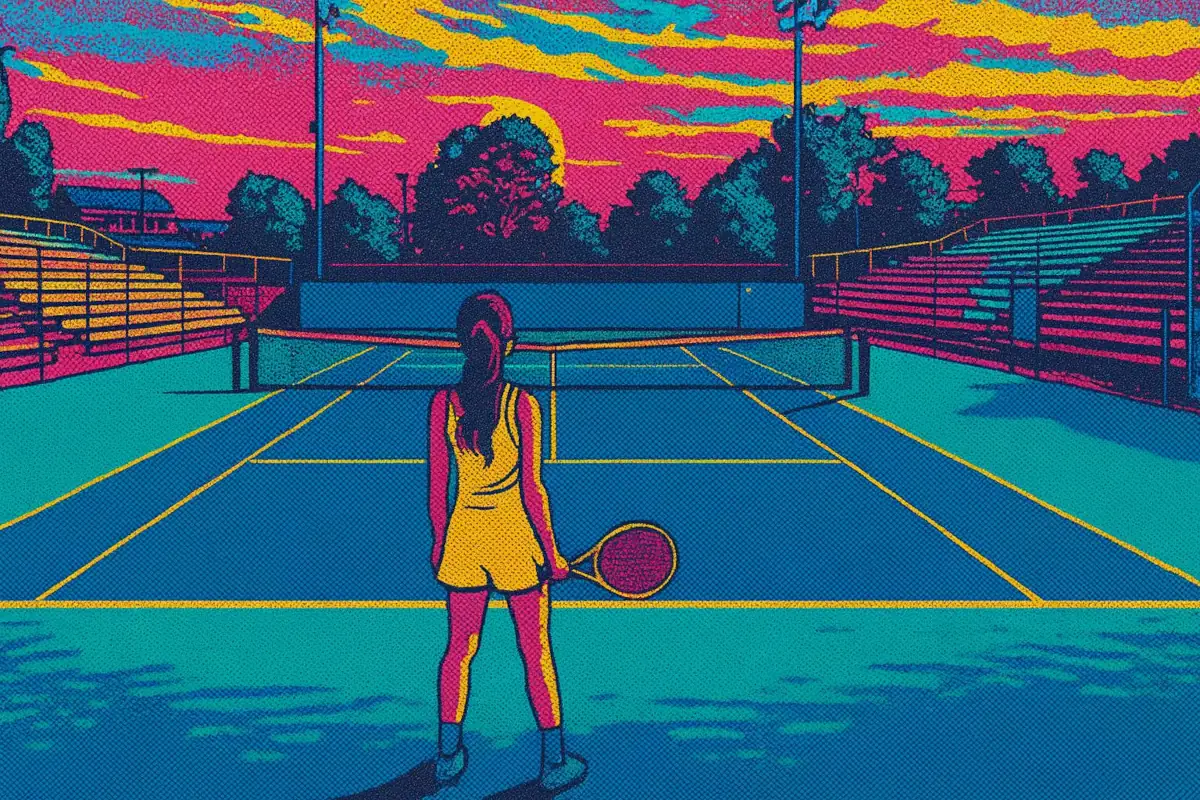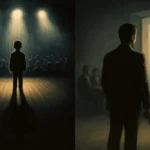From Panic to Presence: The Neuroscience of Clutch Performance
With insights from Dr. Tom Hanson, Steve Wells, Dr. Kevin Chapman, and Dr. Mihaly Csikszentmihalyi
The courts were too quiet.
It wasn’t a true silence, not really. It was a silence made of smaller, sharper sounds that punctuated the void: the rhythmic squeak of sneakers on hardcourt, a dry cough from the sparse crowd, the metallic groan of a folding chair shifting in the late afternoon breeze. But for Olivia, the empty space between those noises was a deafening pressure against her eardrums.
She bounced the tennis ball once, twice, the hollow thwock-thwock echoing the anxious beat in her own chest. The tourna grip of her racket felt all wrong in her hand, too soft and slick, almost wet. She tried to clench her fingers tighter, to force a sense of control, but the sweat was already pooling in her palm, turning her lifeline into a slippery, uncertain thing.
Her first serve toss wobbled into the air, a fraction too high. Her body, trying to compensate, moved with a fatal hesitation. Her shoulder locked, the swing was stiff and jerky, a pale imitation of the fluid motion she owned in practice. The ball clipped the top of the net and dropped dead on her side of the court, an unceremonious punctuation to her failure. A fault.
Clear it. Just clear your head.
Bounce. Bounce. The ritual felt hollow, a prayer to a god she no longer believed in.
Toss.
This time, she overcompensated for her previous timidity, trying to muscle the ball in. Her form collapsed. The second serve sailed long, landing with a soft puff of white paint dust just beyond the seviceline.
Double fault.
From behind the chain-link fence, a low laugh cut through the tense air. It was a sound she could pick out of a stadium roar. She didn’t have to look; she knew it was Tyler. Her opponent’s older brother. He had appointed himself her personal tormentor since last year’s district final, a constant, smirking presence leaning over the fence, tossing out little barbs that were engineered to find the cracks in her focus.
The laugh was followed by a drawled comment, loud enough for the entire court to hear. “That’s the Olivia I remember.”
Her stomach clenched into a cold, heavy knot. The match became a blur of self-destruction. She handed over game after game, a litany of unforced errors. Forehands slammed into the net with a frustrated thud. Backhands floated wide. Returns were limp, defensive chips from a player who had forgotten how to attack. When the final point was lost, she barely registered it. She walked to the net on autopilot, shook her opponent’s hand while muttering a pre-recorded “good match,” and packed her bag without looking anyone in the eye, feeling the weight of their pity and Tyler’s smug satisfaction like a physical shroud.
The Walk Back
The path from the court to the parking lot was a gauntlet of her own insecurities. It wound between two other courts where matches were still in full swing. On her left, she passed Ethan, who was playing with a joyful ferocity, a grin plastered on his face as he smacked a cross-court winner so clean it barely made a sound. On her right, Devon was calmly closing out a tense tiebreak, his movements economical and certain, without a flicker of doubt. He adjusted his strings, took a slow breath, and delivered an ace down the T. Effortless.
Her hands tightened on her racket handle until the grip squeaked in protest. They make it look so easy.
Her own match already felt like an indelible stain spreading across her chest, a cold, dark patch of shame that she couldn’t outrun. It was the familiar, sickening feeling of knowing she was better than she had played, and having no idea how to fix it.
Team Practice — The Introduction
Two days later, the air on Court 1 was thick with humidity and the smell of sun-baked asphalt. The team huddled around Coach Harris after a grueling session of warmups. He stood in the center, his arms crossed loosely over his chest, his expression unreadable.
“Talent is not enough,” he began, his voice carrying easily over the distant pop of balls from the public courts. “Talent gets you to the door. It doesn’t get you through it. If you can’t stay clear-headed when the pressure is on, all that training stays locked inside. Dr. Tom Hanson calls it the ‘choke cycle’: you get tight, you try too hard, your performance drops, which makes you even more anxious, and the cycle repeats.”
He scanned the faces in the group, his eyes lingering for a moment on Olivia. She looked down at her shoes.
“Pressure changes your body,” he continued. “Your heart rate spikes, your breathing gets shallow. It’s a physiological response. As performance psychologist Dr. Kevin Chapman always says: anxiety itself isn’t the enemy. Unmanaged anxiety is the enemy. It hijacks your system. You have to practice regulating your body under perceived intensity, just like you practice your forehand.”
Chris, the team’s sarcastic but good-natured number two, raised a hand. “So, this is where the weird tapping thing comes in?”
“Exactly,” Harris said, a small smile touching his lips. “A psychologist named Steve Wells adapted a technique called EFT specifically for athletes because it’s quick and it works. By gently tapping on certain acupressure points while you acknowledge the stress, you send a calming signal directly to your amygdala—the brain’s alarm system. It tells your system to stand down.”
Harris demonstrated, using two fingers to press firmly just under his collarbone. “Like this. You can do it during a changeover, or even between points. No one even has to know.”
Renee, a freshman with a killer backhand, frowned. “But does it… actually work?”
Devon, the unflappable senior captain, shrugged. “I don’t tap, but I’ve got my own thing. It’s about building a cue that tells your brain to shut up and trust your body. You have to get out of your own way to find what Dr. Mihaly Csikszentmihalyi calls ‘flow’—that state where you’re completely absorbed and everything just happens automatically. That’s the goal for all of us.”
Olivia remained quiet, but the words—choke cycle, unmanaged anxiety, flow—lodged in her mind. They were names for the very things she had been fighting.
The Full Session
When practice officially wrapped, Harris called Olivia over. “I saw your match,” he said simply. “I want to walk you through a full tapping round. The method that Steve Wells teaches. Will you give it a try?”
She gave a reluctant nod.
He led her to a quiet bench. “Okay. Think about that double fault. Where do you feel it in your body, right now?”
“My stomach,” she whispered. “It feels… heavy. Like a rock. And my shoulders… they’re tight.”
“Okay. On a scale of zero to ten?”
“An eight,” she admitted.
“Okay. Repeat after me: ‘Even though I feel this heavy rock in my stomach and all this frustration in my shoulders, I deeply and completely accept myself.’”
She mumbled it. They moved through the tapping points, naming the feelings she had tried to bury.
“This double fault.” (Tap-tap-tap)
“Hearing him laugh.” (Tap-tap-tap)
“This rock in my stomach.” (Tap-tap-tap)
“Feeling like I’m proving him right.” (Tap-tap-tap)
With each round, the intensity lessened. The rock in her stomach didn’t vanish, but it felt smaller, as if the tapping was breaking it down pebble by pebble. Her shoulders lowered. Her breath deepened.
“You see?” Harris said softly. “You’re not erasing the feeling. You’re just turning the volume down. You’re managing the anxiety, just like Dr. Chapman said. Now you can think again.”
The Bad Loss
The week before regionals, the team had a meaningless non-conference match. And of course, Tyler was there.
Olivia played surprisingly well. She won the first set 6-2. In the second, she found herself up 5-3, serving for the match. I’m doing it.
And then, Tyler’s voice sliced through her concentration. “Don’t choke, Olivia. You’re almost there.”
It was the trigger. Instantly, the cold, heavy rock slammed back into her stomach. Her arm felt like lead. This is it, she thought with dawning horror. The choke cycle Dr. Hanson talked about. It’s happening right now. The knowledge did nothing to stop it. She double faulted. The match spiraled out of her control. She lost the set, then the tiebreak.
Walking off the court, she had to pass him. He smirked. “Knew it.”
The shame was a physical assault. The desire to hurl her racket against the fence was immense, but she held on, her knuckles white.
The Semifinal
The semifinal was played at home. During the warmups, Harris told her about Tyler’s sister, Chloe, who had lost her shot at a D1 career to a knee injury. The heckling wasn’t about her; it was about his own ghost.
The match started, and it was a battle. She played tentatively and dropped the first set 6-4.
At the changeover, Harris met her. “Let go of what just happened. Be here, in this chair, on this court. The only way to find that state of flow that Csikszentmihalyi describes is to be completely in the present moment. Let your body do what it knows how to do.”
She went into the second set and immediately went down a break, 2-3. The familiar panic began to rise. Okay, here it is, she thought, her heart hammering. That feeling. Dr. Chapman said the anxiety itself isn’t the problem, it’s letting it run wild. Manage it.
She stepped back from the baseline, turned her back to the court, and pressed her fingers under her collarbone and took two deep long breaths—her abbreviated, discrete version of tapping. She took another look across the net. And then one more deep, slow breath.
Tyler’s voice carried across the court, “She’s cracking!”
But the words sounded different now—hollow and sad. She ignored them, turned back to the court, and delivered an ace.
The rest of the set was a war. She broke serve in a grueling game that left her thighs burning. In her own service game at 4-3, she fell behind 15-40. But her mind was quiet. She held serve, her legs burning, her feet a chorus of squeaks. And as she played, something shifted. She stopped thinking. She was no longer Olivia playing tennis; she was just movement, instinct, and action. The court, the ball, the racket—they were all extensions of her will. After hitting a blistering backhand winner down the line, a thought flashed through her mind. This is it. This is flow. This must be what Csikszentmihalyi meant. She won the set 6-3.
The Final Payoff
The final set was a dogfight. At 5-4, it was Olivia’s serve. Match point.
The old image tried to surface—the double fault, the shame. She turned her back. Pressed her collarbone. One slow breath. Break the cycle, she told herself, thinking of Dr. Hanson. Don’t try too hard. Just trust.
She turned. Bounced the ball. Tossed. The swing was fluid, free. Ace.
Game, set, match.
She didn’t leap or yell. She walked to the net, shook hands. Harris met her at the gate. “That’s clarity,” he said. “You own it now.”
An hour later, the courts were truly empty. Olivia sat alone on the bench, the silence now peaceful. She closed her eyes, feeling the satisfying soreness in her limbs. She hadn’t just won a tennis match. She had faced down Dr. Hanson’s choke cycle. She had learned Dr. Chapman’s lesson about managing anxiety. She had used Steve Wells’s tapping tool to find her center. And in doing so, she had finally, truly experienced the profound, effortless joy of Dr. Csikszentmihalyi’s flow.
She took a final, deep breath, and for the first time in what felt like years, she fully exhaled. The knot was gone. There was only the calm, and the quiet, and the simple, solid knowledge that she had been tested, and she had not broken.



